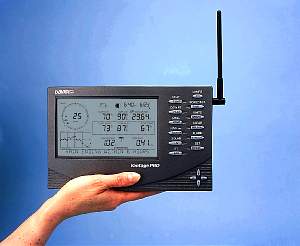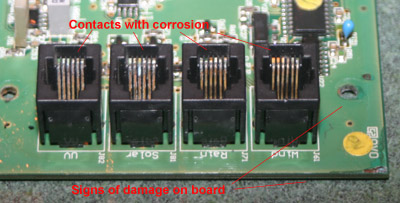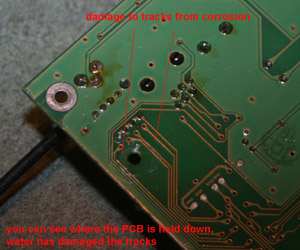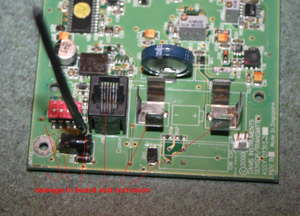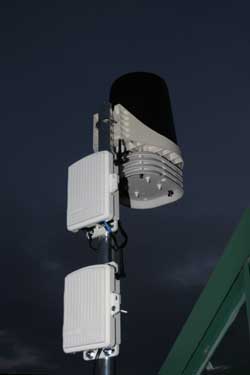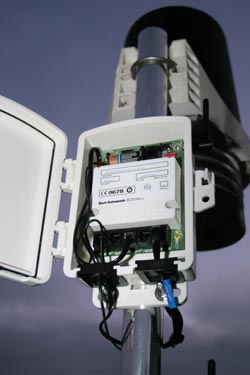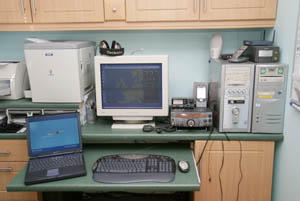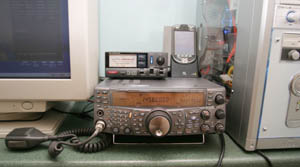 |
|
Information about the UK Storm Guide weather station. |
|
Our Site Home Live Local Weather Lightning
Data Archives This Year Weather Images Burton on Trent - Floods Gust Cloud & Data Lightning 26/07/2006 Lightning 12/08/2004 Lightning Images Shelf Cloud & Data Sun Pillar Tornado - 23/08/2004 Space Photographs Comet
Machholz Useful Stuff Storm
Chasing Miscellaneous
|
I am currently using a Davis Vantage Pro weather station. My system is the wireless one with the ISS mounted on the side of the greenhouse. Whilst I know this is not the best place for temperature readings, however, because of the layout of my garden and surrounding houses it suits the installation better. I have monitored the temperature and compared it to another remote sensor to make sure there was not a major difference in the readings, at the most I gain a degree on very hot days. The second temperature sensor is used in the greenhouse to give me a idea of the best growing times and for early warnings that the temperature is getting low.
The Vantage Pro is an automatic weather station and offers me simple but accurate system for weather watching. Consisting of a screen based console and the ISS, integrated sensor suite, combining a rain collector, temperature and humidity sensors, and anemometer into one package. Easy to fit in other words.
It has been running since February 2002 and has given me a few minor and two major problems. Also the odd signal loss, I have since worked it out to be its dislike to mobile phones, so we have an area in the house where the phones may not be placed.My unit also has the Weather Link data logger that fits neatly into the Vantage Pro console, storing my weather data even when the computer is off. I do however have a PC on all the time to transfer my data over. The software you get is 'Weather Link', you can use this software to create graphs, generate summaries, and of course post the latest data on to this site, the internet updates are done automatically. Storage interval is 10 minutes for me, but you can decide on 1, 5, 10, 15, 30, 60, or 120 minutes.The basic Davis spec reads like this. Vantage Pro console/receiver, integrated sensor suite, and mounting hardware. Integrated sensor suite includes rain collector, temperature and humidity sensors, anemometer, 40' (12 m) anemometer cable, and solar panel. Temperature and humidity sensors are enclosed in standard radiation shield. Sensor suite is solar powered. Transmitter and battery are located inside radiation shield. The console may be powered using the included AC-power adapter or with three C batteries (not included).Wireless range is up to 400' (120 m) outdoors, line of sight. Typical range through walls under most conditions is 75' to 150' (23 to 46 m). Add wireless repeaters for distances up to 0.6 miles (1 km). Overall I am pleased with the unit, but it has cost me a few pounds over time to repair and maintain the system. Some of the Issues I have had with the Davis Weather Station . Failure List 1, Anemometer reed switch failed, within 2 years, Covered under warranty and replaced within a week. Only cost postage. 2, ISS PCB board failed, out of warranty. Repaired and re-weather proofed with PCB lacquer by myself. This lasted another year and a half. Cost, Time, Lacquer from RS, PCB Cleaner from RS, £20 aprox
3, ISS PCB board failed, out of warranty. Now no longer worth the repair the DIP switch and antenna had corroded from the inside, PCB tracks had so much damage on them that the resistance had risen and transmitting problems had become more of a problem. Resorted to spending nearly £200 on an upgrade kit.
So watch out, the VP1 is a great bit of kit, but it will cost you to maintain it. Davis are not the best to deal with at times either. They just want your money! I have plans to add a motorised colour camera to the mast to allow for a web cam view across the valley, I have a low light Black and White one on the mast at the moment, great by night, not so good in the day. I also have a Boltek PCI Stormtracker with a range of just on 1000 miles. I have been using this for a while now and have found it to be great for storm watching and chasing. I have used two bits of software so far with the Boltek, Astrogenic Systems Nextstorm was my first and then I moved over to the more expensive Aninoquisi Lightning 2000. I have now moved back to Nexstorm due to joining the StrikeStar Network and only NexStorm supports StrikeStar. StrikeStar is some triangulation software that takes data off lightning detectors throughout the UK and Europe and averages the data to give a more precise position of the storms. The Boltek Antenna placement is 27ft up on the outside of the house. The Boltek antenna is about the size of a packet of cigarettes and not waterproof. I had to find a way of mounting it and I wanted it outside rather than in the loft . I mounted it mounted inside a length of white plastic drain pipe and is held in place by plastic screws (don't use any metal to mount it) and a metal T & K mast mount at the bottom to hold it to the wall. The top of the pipe is sealed with a rubber bung also bought for the builders merchants. Simple, cost effective and looks tidy.
|
The layout, design and content of this web-site are the copyright material of Steven J Warren.
Copyright 2009 All rights reserved.
DESIGN - www.FlyingBunnyStudio.com
NOT FOR PROTECTION OF LIFE OR PROPERTY
The information here is provided for general interest.

